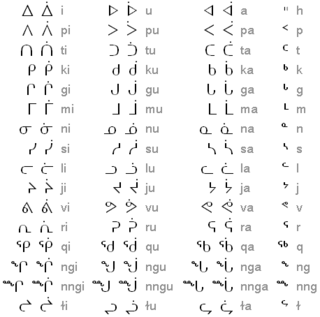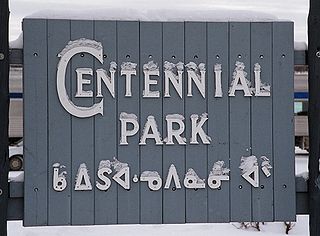
Cree is a dialect continuum of Algonquian languages spoken by approximately 86,475 indigenous people across Canada in 2021, from the Northwest Territories to Alberta to Labrador. If considered one language, it is the aboriginal language with the highest number of speakers in Canada. The only region where Cree has any official status is in the Northwest Territories, alongside eight other aboriginal languages. There, Cree is spoken mainly in Fort Smith and Hay River.

Inuktitut syllabics is an abugida-type writing system used in Canada by the Inuktitut-speaking Inuit of the territory of Nunavut and the Nunavik and Nunatsiavut regions of Quebec and Labrador, respectively. In 1976, the Language Commission of the Inuit Cultural Institute made it the co-official script for the Inuit languages, along with the Latin script.
When used as a diacritic mark, the term dot refers to the glyphs "combining dot above", and "combining dot below" which may be combined with some letters of the extended Latin alphabets in use in a variety of languages. Similar marks are used with other scripts.
A ring diacritic may appear above or below letters. It may be combined with some letters of the extended Latin alphabets in various contexts.

Inuktitut, also known as Eastern Canadian Inuktitut, is one of the principal Inuit languages of Canada. It is spoken in all areas north of the North American tree line, including parts of the provinces of Newfoundland and Labrador, Quebec, to some extent in northeastern Manitoba as well as the Northwest Territories and Nunavut. It is one of the aboriginal languages written with Canadian Aboriginal syllabics.

Canadian syllabic writing, or simply syllabics, is a family of writing systems used in a number of Indigenous Canadian languages of the Algonquian, Inuit, and (formerly) Athabaskan language families. These languages had no formal writing system previously. They are valued for their distinctiveness from the Latin script and for the ease with which literacy can be achieved. For instance, by the late 19th century the Cree had achieved what may have been one of the highest rates of literacy in the world.

Cree syllabics are the versions of Canadian Aboriginal syllabics used to write Cree dialects, including the original syllabics system created for Cree and Ojibwe. There are two main varieties of syllabics for Cree: Western Cree syllabics and Eastern Cree syllabics. Syllabics were later adapted to several other languages. It is estimated that over 70,000 Algonquian-speaking people use the script, from Saskatchewan in the west to Hudson Bay in the east, the US border to Mackenzie and Kewatin in the north.

Western Cree syllabics are a variant of Canadian Aboriginal syllabics used to write Plains Cree, Woods Cree and the western dialects of Swampy Cree. It is used for all Cree dialects west of approximately the Manitoba–Ontario border in Canada, as opposed to Eastern Cree syllabics. It is also occasionally used by a few Cree speakers in the United States.
In Latin script, the double hyphen⹀ is a punctuation mark that consists of two parallel hyphens. It was a development of the earlier double oblique hyphen⸗, which developed from a Central European variant of the virgule slash, originally a form of scratch comma. Similar marks are used in other scripts.
Eastern Cree syllabics are a variant of Canadian Aboriginal syllabics used to write all the Cree dialects from Moosonee, Ontario to Kawawachikamach on the Quebec–Labrador border in Canada that use syllabics.
Potawatomi is a Central Algonquian language. It was historically spoken by the Pottawatomi people who lived around the Great Lakes in what are now Michigan and Wisconsin in the United States, and in southern Ontario in Canada. Federally recognized tribes in Michigan and Oklahoma are working to revive the language.

Ojibwe is an indigenous language of North America from the Algonquian language family. Ojibwe is one of the largest Native American languages north of Mexico in terms of number of speakers and is characterized by a series of dialects, some of which differ significantly. The dialects of Ojibwe are spoken in Canada from southwestern Quebec, through Ontario, Manitoba and parts of Saskatchewan, with outlying communities in Alberta and British Columbia, and in the United States from Michigan through Wisconsin and Minnesota, with a number of communities in North Dakota and Montana, as well as migrant groups in Kansas and Oklahoma.
The Severn Ojibwa or the Oji-Cree language is the indigenous name for a dialect of the Ojibwe language spoken in a series of Oji-Cree communities in northern Ontario and at Island Lake, Manitoba, Canada. Ojibwa is a member of the Algonquian language family, itself a member of the Algic language family.
Yi Syllables is a Unicode block containing the 1,165 characters of the Liangshan Standard Yi script for writing the Nuosu language.
In the Unicode standard, a plane is a contiguous group of 65,536 (216) code points. There are 17 planes, identified by the numbers 0 to 16, which corresponds with the possible values 00–1016 of the first two positions in six position hexadecimal format (U+hhhhhh). Plane 0 is the Basic Multilingual Plane (BMP), which contains most commonly used characters. The higher planes 1 through 16 are called "supplementary planes". The last code point in Unicode is the last code point in plane 16, U+10FFFF. As of Unicode version 15.1, five of the planes have assigned code points (characters), and seven are named.

Natchilingmiutut (ᓇᑦᕠᓕᖕᒥᐅᑐᑦ), Netsilik, Natsilik, Nattilik, Netsilingmiut, Natsilingmiutut, Nattilingmiutut, or Nattiliŋmiutut is an Inuit language variety spoken in western Nunavut, Canada, by Netsilik Inuit.
Unified Canadian Aboriginal Syllabics Extended is a Unicode block containing extensions to the Canadian syllabics contained in the Unified Canadian Aboriginal Syllabics Unicode block for some dialects of Cree, Ojibwe, Dene, and Carrier.
Cherokee is a Unicode block containing the syllabic characters for writing the Cherokee language. When Cherokee was first added to Unicode in version 3.0 it was treated as a unicameral alphabet, but in version 8.0 it was redefined as a bicameral script. The Cherokee block contains all the uppercase letters plus six lowercase letters. The Cherokee Supplement block, added in version 8.0, contains the rest of the lowercase letters. For backwards compatibility, the Unicode case folding algorithm—which usually converts a string to lowercase characters—maps Cherokee characters to uppercase.
Cherokee Supplement is a Unicode block containing the syllabic characters for writing the Cherokee language. When Cherokee was first added to Unicode in version 3.0 it was treated as a unicameral alphabet, but in version 8.0 it was redefined as a bicameral script. The Cherokee Supplement block contains lowercase letters only, whereas the Cherokee block contains all the uppercase letters, together with six lowercase letters. For backwards compatibility, the Unicode case folding algorithm—which usually converts a string to lowercase characters—maps Cherokee characters to uppercase.
Unified Canadian Aboriginal Syllabics Extended-A is a Unicode block containing extensions to the Canadian syllabics contained in the Unified Canadian Aboriginal Syllabics Unicode block. The extension adds missing characters for Nattilik and historical characters for Cree and Ojibwe.




